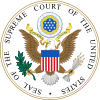
The Fifteenth Amendment to the United States Constitution prohibits the federal government and each state from denying or abridging a citizen's right to vote "on account of race, color, or previous condition of servitude." It was ratified on February 3, 1870, as the third and last of the Reconstruction Amendments.

The Voting Rights Act of 1965 is a landmark piece of federal legislation in the United States that prohibits racial discrimination in voting. It was signed into law by President Lyndon B. Johnson during the height of the civil rights movement on August 6, 1965, and Congress later amended the Act five times to expand its protections. Designed to enforce the voting rights protected by the Fourteenth and Fifteenth Amendments to the United States Constitution, the Act sought to secure the right to vote for racial minorities throughout the country, especially in the South. According to the U.S. Department of Justice, the Act is considered to be the most effective piece of federal civil rights legislation ever enacted in the country. The National Archives and Records Administration stated: "The Voting Rights Act of 1965 was the most significant statutory change in the relationship between the federal and state governments in the area of voting since the Reconstruction period following the Civil War".
Baker v. Carr, 369 U.S. 186 (1962), was a landmark United States Supreme Court case in which the Court held that redistricting qualifies as a justiciable question under the equal protection clause of the Fourteenth Amendment, thus enabling federal courts to hear Fourteenth Amendment-based redistricting cases. The court summarized its Baker holding in a later decision as follows: "the Equal Protection Clause of the Fourteenth Amendment limits the authority of a State Legislature in designing the geographical districts from which representatives are chosen either for the State Legislature or for the Federal House of Representatives.". The court had previously held in Gomillion v. Lightfoot that districting claims over racial discrimination could be brought under the Fifteenth Amendment.
United States v. Cruikshank, 92 U.S. 542 (1876), was a landmark decision of the United States Supreme Court ruling that the U.S. Bill of Rights did not limit the power of private actors or state governments despite the adoption of the Fourteenth Amendment. It reversed the federal criminal convictions for the civil rights violations committed in aid of anti-Reconstruction murders. Decided during the Reconstruction Era, the case represented a major defeat for federal efforts to protect the civil rights of African Americans.
The Equal Protection Clause is part of the first section of the Fourteenth Amendment to the United States Constitution. The clause, which took effect in 1868, provides "nor shall any State ... deny to any person within its jurisdiction the equal protection of the laws." It mandates that individuals in similar situations be treated equally by the law.

The NAACP Legal Defense and Educational Fund, Inc. is an American civil rights organization and law firm based in New York City.
Yick Wo v. Hopkins, 118 U.S. 356 (1886), was a landmark decision of the United States Supreme Court in which the Court ruled that a prima facie race-neutral law administered in a prejudicial manner infringed upon the right to equal protection guaranteed by the Fourteenth Amendment to the U.S. Constitution.
Ex parte Young, 209 U.S. 123 (1908), is a United States Supreme Court case that allows suits in federal courts for injunctions against officials acting on behalf of states of the union to proceed despite the State's sovereign immunity, when the State acted contrary to any federal law or contrary to the Constitution.
Washington v. Davis, 426 U.S. 229 (1976), was a United States Supreme Court case that established that laws that have a racially discriminatory effect but were not adopted to advance a racially discriminatory purpose are valid under the U.S. Constitution.
Bray v. Alexandria Women's Health Clinic, 506 U.S. 263 (1993) is a United States Supreme Court case in which the court held that Section 1985(3) of The Civil Rights Act of 1871 does not provide a federal cause of action against persons obstructing access to abortion clinics. Alexandria Health Clinic, along with several other abortion clinics, sued to prevent Jayne Bray and other anti-abortion protesters from blocking the entrance to clinics in Washington D.C.
Williams v. Mississippi, 170 U.S. 213 (1898), is a United States Supreme Court case that reviewed provisions of the 1890 Mississippi constitution and its statutes that set requirements for voter registration, including poll tax, literacy tests, the grandfather clause, and the requirement that only registered voters could serve on juries. The plaintiff, Henry Williams, claimed that Mississippi's voting laws were upheld with the intent to disenfranchise African Americans, thus violating the Fourteenth Amendment. The U.S. Supreme Court did not find discrimination in the state's laws because, even though the laws made discrimination possible, the laws themselves did not discriminate against African Americans. The court found that any discrimination toward African Americans was performed by the administrative officers enforcing the law and that there was no judicial remedy for this kind of discrimination.
Gomillion v. Lightfoot, 364 U.S. 339 (1960), was a landmark decision of the Supreme Court of the United States that found an electoral district with boundaries created to disenfranchise African Americans violated the Fifteenth Amendment.

Shaw v. Reno, 509 U.S. 630 (1993), was a landmark United States Supreme Court case in the area of redistricting and racial gerrymandering. After the 1990 census, North Carolina qualified to have a 12th district and drew it in a distinct snake-like manner in order to create a "majority-minority" Black district. From there, Ruth O. Shaw sued to challenge this proposed plan with the argument that this 12th district was unconstitutional and violated the Fourteenth Amendment under the clause of equal protection. In contrast, Reno, the Attorney General, argued that the district would allow for minority groups to have a voice in elections. In the decision, the court ruled in a 5–4 majority that redistricting based on race must be held to a standard of strict scrutiny under the equal protection clause and on the basis that it violated the Fourteenth Amendment because it was drawn solely based on race.
Mobile v. Bolden, 446 U.S. 55 (1980), was a case in which the Supreme Court of the United States held that disproportionate effects alone, absent purposeful discrimination, are insufficient to establish a claim of racial discrimination affecting voting.
White primaries were primary elections held in the Southern United States in which only white voters were permitted to participate. Statewide white primaries were established by the state Democratic Party units or by state legislatures in South Carolina (1896), Florida (1902), Mississippi and Alabama, Texas (1905), Louisiana and Arkansas (1906), and Georgia (1900). Since winning the Democratic primary in the South almost always meant winning the general election, barring black and other minority voters meant they were in essence disenfranchised. Southern states also passed laws and constitutions with provisions to raise barriers to voter registration, completing disenfranchisement from 1890 to 1908 in all states of the former Confederacy.
Levy v. Louisiana, 391 U.S. 68 (1968), is a decision of the Supreme Court of the United States. This decision deals primarily with the civil rights of illegitimate children, specifically regarding their ability to sue on a deceased parent's behalf. It held that the right of recovery may not be denied merely because a person is the illegitimate child of the deceased because such a law would violate the Equal Protection Clause of the Fourteenth Amendment.
Williams v. Rhodes, 393 U.S. 23 (1968), is a decision by the United States Supreme Court which held that Ohio had violated the equal protection rights under the Fourteenth Amendment of two political parties by refusing to print their candidates' names on the ballot.
Hunter v. Underwood, 471 U.S. 222 (1985), was a case in which the Supreme Court of the United States unanimously invalidated the criminal disenfranchisement provision of § 182 of the Alabama Constitution as a violation of the Equal Protection Clause of the Fourteenth Amendment to the U.S. Constitution.
Thornburg v. Gingles, 478 U.S. 30 (1986), was a United States Supreme Court case in which a unanimous Court found that "the legacy of official discrimination ... acted in concert with the multimember districting scheme to impair the ability of "cohesive groups of black voters to participate equally in the political process and to elect candidates of their choice." The ruling resulted in the invalidation of districts in the North Carolina General Assembly and led to more single-member districts in state legislatures.
Gaffney v. Cummings, 412 U.S. 735 (1973), is a Supreme Court decision upholding statewide legislative apportionment plans for Connecticut. The Court admitted that these plans entailed "substantial inequalities in the population of the representative districts." It observed that "the States have made virtually no attempt to justify their failure 'to construct districts ... as nearly of equal population as is practicable." It was a Fourteenth Amendment case. At issue was whether the election districts had been gerrymandered in violation of the Fourteenth Amendment to the Constitution.




